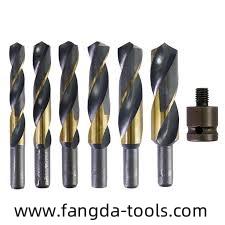How Can Operators Reduce Wear on Fangda HSS Twist Drill Bit?

Ensuring reliable performance in metal drilling requires attention to both the lifespan of the tool and its precise design. Fangda offers high-quality HSS Twist Drill Bit solutions engineered to deliver durability, accuracy, and efficiency across various applications. This article examines how material toughness, design geometry, and operational considerations contribute to lasting, professional results.
Tool durability is influenced by both material composition and usage patterns. High-speed steel provides toughness and wear resistance, allowing drill bits to retain sharp edges even under frequent or intensive use. Consistent feed rates, controlled drilling speed, and correct alignment reduce stress on the cutting edges, minimizing micro-fractures and wear. Understanding how different metals respond to drilling pressure and heat helps operators prolong tool life and maintain high-quality outcomes.
Geometry plays a critical role in cutting efficiency and precision. The point angle determines penetration efficiency, while the spiral angle affects chip removal and heat dissipation. Selecting the correct diameter and length for the intended application ensures stability and minimizes tool deflection. Drill bits with optimized geometry maintain consistent hole dimensions, reduce energy consumption, and prevent damage to both the tool and the workpiece.
Heat management is another important factor affecting durability. During continuous or high-volume drilling, friction generates heat that can soften cutting edges and reduce performance. Drill bits with well-designed geometry facilitate proper chip evacuation, while operators can further prevent overheating by moderating speed, using intermittent drilling, and ensuring proper lubrication or cooling when necessary. These measures extend the lifespan of each bit significantly.
Advanced geometry supports specialized applications. Longer drill bits enable deep-hole drilling without bending, while short, rigid bits provide stability for surface-level tasks. For metals of varying hardness, point modifications and reinforced tips improve penetration and reduce wear. Combining geometric optimization with material understanding allows operators to adapt to complex projects with minimal tool replacement or maintenance interruptions.
Operator technique complements the durability and geometry of the drill bit. Maintaining steady pressure, using guides or clamps, and ensuring perpendicular alignment prevents deviation and preserves cutting edges. Awareness of material hardness, thickness, and grain structure allows operators to select the appropriate feed rates, reducing unnecessary strain and extending the overall service life of the tool.
Market conditions also impact tool selection. Rising costs of high-grade steel and other alloys drive innovation in design and material efficiency. Manufacturers invest in developing drill bits that maintain durability while optimizing geometry for specific applications. Understanding market trends allows users to choose bits that balance cost-effectiveness with long-term performance, supporting both industrial and home projects.By integrating material toughness, advanced geometry, and informed operational practices, Fangda ensures that every HSS Twist Drill Bit provides consistent precision, reliability, and extended service life. Discover high-performance options suitable for a variety of drilling needs at https://www.fangda-tools.com/product/hss-straight-shank-twist-drill/
- Art
- Causes
- Crafts
- Dance
- Drinks
- Film
- Fitness
- Food
- Games
- Gardening
- Health
- Home
- Literature
- Music
- Networking
- Other
- Party
- Religion
- Shopping
- Sports
- Theater
- Wellness



